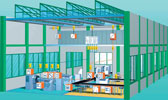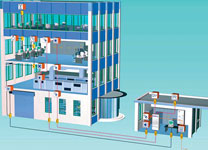

The availability and reliability required for bus systems, measuring and plant control, and IT systems in industry is very high. Manufacturing execution systems (MES) are part and parcel of the lifeblood of many organisations. But how much consideration is given to the protection of such systems against lightning and power surges?
What happens when the 'black box' goes bang? Sinetech, in partnership with Surgetek, are local suppliers of the highly-regarded Dehn product range offering a wide variety of system power protection solutions to customers seeking minimised downtime and high reliability of their industrial and IT-managed systems. While many customers readily purchase the standard mains power protection systems to guard against lightning-induced and line power surges to cover either their domestic or business needs, few customers consider the equally important needs of protecting their industrial systems or data management (telecom/telemetry) systems.
Generally, most vendors of plant business systems involving the integration of scada, process control, and control systems hardware/software, provide limited protection against voltage and current transients in their equipment and to the actuators/sensors attached to the system. It is assumed that the customer has taken care of these requirements, often with the provision of UPSs to ensure clean power supplies to essential equipment.
Our experience shows that in many organisations power protection is often confined to the company's computer facilities in the business system (ERP) environment. Out on the factory floor, down in the basement, out at the boiler house no such protection is supplied.
So let us look at what one can do to provide improved surge protection.

Surges
Surges are the most frequent cause of damage (see Sidebar below). Approximately 24 out of 100 cases of damage to electronic equipment are caused by surges. Therefore, surges are by far the most frequent cause of damage as shown in a recent study by Württembergische Versicherung of over 7370 cases in Germany. Anyone in business that has escaped that event up to now, has either been lucky - as is seen by the statistics - or has made provisions for protection.
Surges and their paths into measuring and control systems
Surges are momentary peak voltages, so called 'transient voltages' arising for only some milliseconds. They reach peak values of up to some 10 000 V.
These surges are caused by:
* Direct lightning strikes.
* Indirect lightning strikes within a distance of up to a few kilometres.
* Switching operations within the power supply system.
* Interferences due to internal switching operations.
Electronic equipment can be destroyed by both powerful impulses out of atmospheric discharges and peak voltages out of switching operations.
The path of surges into installations is unpredictable: They interfere with or destroy equipment by entering the installation via signal and data lines or power supply lines.

Automation
Groundbreaking changes in automation and control systems have become evident within the last few years. The increasing variety of industrial products as well as flexible utilisation of buildings and installations requires the maximum level of automation in a line of processes depending on each other. Therefore, safe and fast communication among the processes is an indispensable factor.
A long chain of highly-integrated microelectronic components is responsible for transferring the enormous flood of process information. As everyone knows, a chain is as strong as its weakest link. But what happens if one link of the chain is broken? Failures are unacceptable for processes.
Surges hit the most sensitive equipment first, ie, those responsible for the transmission of information. These are for example, programmable logic controls (PLCs), control units, measuring sensors and transmission equipment. If only one link of this chain fails due to surges, the whole system is paralysed. The resulting consequences can be severe:
* Production standstill.
* No receipt or dispatch of goods.
* Failing emergency circuits, mal-operation, programme faults.
* Last but not least, life hazards.

Who is responsible?
Electronics insurance potentially covers the damage to hardware, provided cover was taken out. But who is responsible for the subsequent damage caused by data loss, production standstill or even personal injury?
Is it the system designer, who intends to project a trendsetting installation based on the latest state-of-the-art? Is it the contracted installation engineer, who has promised to implement an efficient installation? Or is it the user, who is responsible for the operation of the process?
It does not matter who is responsible for a single case, all of them bear the consequences: the designer who could have known better, the installation engineer who will struggle to get further business and the plant user for whom the loss of production is not recoverable.
Surge protection in data and power supply systems
Almost every measuring and control device needs electrical power to work. In most cases it is supplied directly from the power network. Moreover, there are many interfaces between measuring and control systems and data networks (LANs) or telecommunication networks (WANs). Effective protection for measuring and control equipment unifies the treatment of all system interfaces in one protection concept.
Power supply and data networks can be protected by lightning current arresters, surge arresters and protective devices especially adapted to individual applications.
Sinetech's technical documentation provides detailed information about the protection concepts and makes the choice of the correct surge protection device easier. The Dehn surge protective devices are well-suited for many applications. Following are some examples.
Process control and automation systems
* RS485 - Fieldbus interface: On the process control level, 'high-tech' components are interconnected via twisted pair lines. The requirement for 'realtime capability' on processes resulted in a development of especially fast and therefore sensitive fieldbus systems. The bus cabling structure can be extended over several kilometres.
Protection: Where a bus line enters the building, one lightning current arrester eg, Blitzductor CT BD HF 5 (LPZ 0A/2) has to be installed per pair of lines. Shield earthing at low impedance directly at the protective device is recommended. For fine protection of Profibus-DP devices, the surge protective adapter FS 9E PB 6 (LPZ 2/3) is simply plugged in.
* Sensor-actuator interface: Correct processing requires a lot of information and a number of actions. The sensors record process data and the actuators control the process.
Protection: Just like the sensitive control units, the production lines are also divided into lightning protection zones. Suitable protective devices at the zone boundaries (Lightning Protection Zone 1 to 2) limit upcoming surges. For protecting multicore cables, DEHNconnect RK surge protective terminal blocks are especially suitable. An AS interface, for example, requires an especially-adapted surge protection module.
Analog measuring equipment
* Weighing systems: Electromechanical weighing systems are often designed in 6-wire configurations.
One pair of lines is used for the power supply, one for transmission of measuring values and one for compensation of the cable length.
Protection: As weighing systems are located outdoors, they are exposed to direct lightning strokes. The loadcells as well as the measuring sensors should be protected by lightning current proof SPDs Type Blitzductor (LPZ 0A/2). In order to attenuate electromagnetic interferences, a low-impedance shield connection for multicore lines is employed.
* Intrinsically safe circuits: Intrinsic safety as a type of protection is based on power limitation in a measuring circuit. The measured values are often transmitted as injected currents. Additionally, remote supply for the measuring sensors can be performed via the signal lines.
Protection: In the process engineering industry, very good equipotential bonding is provided between the individual installations (LPZ 1/2). Surge arresters eg, Blitzductor MD EX, are therefore designed to provide protection of equipment not directly exposed to lightning. In addition, the self-inductance and -capacitance of the ATEX-certified SPD may be neglected for laying the measuring circuit. Because of its design in accordance with FISCO, it can also be used in intrinsically-safe bus circuits without problem.
Building services management systems
These optimise the lighting, communication and power distribution within buildings. Bus systems interconnect high-tech measuring sensors and control units. The lines are mostly laid in line-, tree- or star topology.
Protection: If a bus line is installed between buildings, a lightning current arrester Blitzductor CT Type B (LPZ 0A/1) or Blitzductor CT Type B ... (LPZ 0A/2) has to be installed at the service entrance and connected with each pair of lines. Depending on the system, the internal measuring and control units are protected by different SPDs. For example, EIB bus couplers are furnished with BUStectors instead of normal bus terminals (LPZ 1/2).
Alarm systems
Control boards of alarm systems combine all signals of the connected fire and security alarm systems. Many detectors, which are widely spread over complex installations, are interconnected. The control board releases the alarm when one of the detectors is activated.
Protection: For protecting the control board and the detectors, combined lightning current and surge arresters Blitzductor CT Type BE are installed at each service entrance. As the 'combined SPD' controls lightning currents and surges, a direct transition from LPZ 0A to 2 is possible with only one SPD. Blitzductor CT is also suitable for protecting the signal lines. If the control board is equipped with an automatic dialling system for calling via a direct exchange line, this must also be protected.
In summary
So there you have it: you can have your cake and eat it with the understanding that your installation is protected against everything except thermonuclear global warfare or equipment failure by natural causes.
Sinetech has publications available for interested readers: 'Surge Protection: Easy choice' (DS 649 E); 'Surge Protection: Safety for Your Data Networks' (DS 647 E).

© Technews Publishing (Pty) Ltd | All Rights Reserved